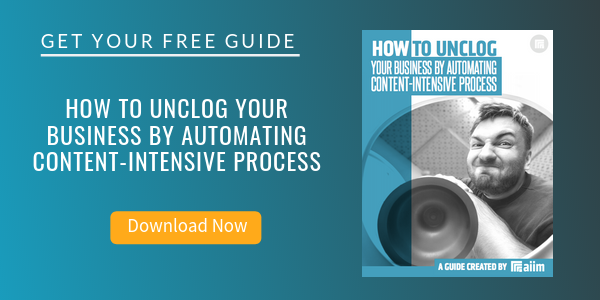
The Last Mile Is an Overlooked Process 'Moment of Truth'
Business Process Management (BPM) | Logistics
A “moment of truth” is a deciding instant that determines whether something will succeed.
According to Wikipedia, “Transporting goods via freight rail networks and container ships is often the most efficient and cost-effective manner of shipping. However, when goods arrive at a high-capacity freight station or port, they must then be transported to their final destination. This last leg of the supply chain is often less efficient, comprising up to 28% of the total cost to move goods. This has become known as the last mile problem."
Even though today’s transportation and logistics industry has globalized and adopted technology for many purposes, it still relies heavily on such paper documents as Bills of Lading, Delivery Receipts, Commercial Invoices, and Claims forms to convey information. Found at various stages of the supply chain, these documents are typically printed out and then manually keyed into another electronic system. Unfortunately, this manual data entry translates into information delays, human errors, and hours of redundant labor.
For many organizations, the “last mile” of the distribution process – whether products are delivered to another business or to an end consumer – is a key and often overlooked process moment of truth. And Proof of Delivery (POD) documents are a key factor in manual last mile inefficiencies.
Here are 5 reasons to get serious about the “last mile” problem.
1. Cost Reduction
The last leg of any shipment delivery can be one of the least efficient and least visible from the point of tracking and information flow. The cost for this last move can be up to 28 percent of the total cost of the shipment. Poor visibility into when goods are delivered, resulting from the late capture of proof of delivery, can increase the operational costs. Cutting edge companies use mobile technology to allow any delivery individual to capture and submit a Delivery Receipt or signed Bill of Lading.
Beyond the immediate direct costs involved when drivers must process paper documents, there are also a variety of additional costs that must be considered in a manual proof-of-deIivery (POD) process:
- The re-keying of PODs that is needed in order to actually create an invoice.
- The errors the inevitably creep into this manual process.
- Salaries for the people who photocopy, scan, and fiIe the PODs for record-keeping purposes.
- All the physical resources – space, paper, printers – needed to manage this paper.
Increased customer service costs to find documentation related to customer questions and disputes.
The economics of automating POD documentation can be significant. For example, NFT is the UK’s leading provider of chilled, time-critical food and drink logistics solutions. It provides primary and secondary logistics to simplify the chilled food and drink supply chains for a wide range of customers including major European brand and private label manufacturers and importers, regional food and drink manufacturers and leading UK and European grocery retailers. A company like NFT typically handles 100,000 PODs every week. By automating this process, they directly saved over £100,000 in production costs.
2. The Impact of “Last Mile” Automation on “Upstream” Processes
Switching from paper to electronic proof of delivery improves delivery and collection accuracy by allowing delivery drivers to scan deliveries, accept signatures, update inventory, and log new customer orders on a mobile device. This means that data is immediately available for “upstream” systems for billing and inventory updates. Automating the last mile of the process ultimately improves all of the other systems that rely upon POD documentation. For companies that are responsible for delivery as well as operating their own distribution centers, proof-of-delivery software automation can provide transparency and data that can also be used to improve warehouse efficiency.
3. Revenue Generation
Initiating a billing process from a delivery persons’ mobile phone through automatic capture of delivery receipts via mobile camera can dramatically accelerate revenue collection and recognition. Capturing, recognizing and extracting key data held within a simple Delivery Receipt can initiate a billing process and, via existing electronic systems, provide both the shipper and receiver in real time a copy of the signed POD.
Paper is still a common format not only for POD documents, but also for invoices. Processing paper invoices not only requires entering invoice data but also matching to other documents (like Proof of Delivery) to confirm and approve invoice contents. By streamlining the connection between last mile documents and invoice processing, organizations realize benefits in Accounts Payable like paying invoices accurately, growing business without increasing staff, maintaining good relationships with suppliers and improving budgeting and forecasting.
4. There is a technology revolution underway through the distribution value chain, but especially in the “last mile”
Rapidly changing transportation and logistics dynamics in B2C (business-to-consumer) companies will inevitably translate into changes for B2B companies (business-to-business). In Parcel delivery – The future of last mile, McKinsey summarizes the dramatic changes going on in the “last mile” for B2C companies:
...the last mile’s hefty share in total parcel delivery cost – often reaching or even exceeding 50 percent – makes it a key process step for those seeking to gain a competitive advantage. At the same time, it is precisely at the last mile that many incumbents are struggling, as they often shoulder significant labor cost disadvantages and therefore, all else being equal, competitive disadvantages.
If a company operates in a high-labor-cost country, it better starts thinking about the future of the last mile now, as key foundations in HR, IT, and the investment strategy need to be laid down. Companies that fail to act soon will forfeit their chance to be among the contenders for the last mile in the long term.
While the issues associated with “last mile” package delivery to homes via drones and autonomous vehicles are different than the issues facing B2B companies, radical innovations in the consumer sector cannot help but migrate into B2B companies. Organizations should prepare for the next wave of changes by immediately focusing on eliminating paper documents as Bills of Lading, Delivery Receipts, Commercial Invoices and Claims forms.
5. Tackling “last mile” paper documentation can be a springboard to broader Digital Transformation efforts
Digital Transformation initiatives are often thought of in “Big Bang” terms – some massive and complex initiative that – hopefully – yields dramatic returns.
But the reality of most Digital Transformation initiatives is that their success rests on the aggregation of a series of individual process improvements. The “last mile” is a good example of a process that has a significant ripple effect not only within a company, but also with customers.
NFT has seen their effort to automate PODs yield significant benefits beyond immediate cost savings. Over 85% of PODs can now be viewed throughout the company on the same day, creating significant improvements in other processes for which manual PODs were previously an obstacle. In addition, NFT customers such as Tesco, ASDA, Sainsbury’s and Morrisons now have direct access to all delivery documentation enabling them to rapidly locate and resolve discrepancies and keep on top of supermarket returns.
Every request is automatically allocated to an advisor for action and a powerful reporting capability allows NFT to effectively measure and manage the performance of the customer services team to ensure that targets for improving service levels and customer satisfaction are met.
About John Mancini
John Mancini is the President of Content Results, LLC and the Past President of AIIM. He is a well-known author, speaker, and advisor on information management, digital transformation and intelligent automation. John is a frequent keynote speaker and author of more than 30 eBooks on a variety of topics. He can be found on Twitter, LinkedIn and Facebook as jmancini77. Recent keynote topics include: The Stairway to Digital Transformation Navigating Disruptive Waters — 4 Things You Need to Know to Build Your Digital Transformation Strategy Getting Ahead of the Digital Transformation Curve Viewing Information Management Through a New Lens Digital Disruption: 6 Strategies to Avoid Being “Blockbustered” Specialties: Keynote speaker and writer on AI, RPA, intelligent Information Management, Intelligent Automation and Digital Transformation. Consensus-building with Boards to create strategic focus, action, and accountability. Extensive public speaking and public relations work Conversant and experienced in major technology issues and trends. Expert on inbound and content marketing, particularly in an association environment and on the Hubspot platform. John is a Phi Beta Kappa graduate of the College of William and Mary, and holds an M.A. in Public Policy from the Woodrow Wilson School at Princeton University.



